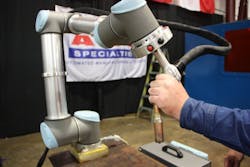The rise of collaborative robots (cobots) in industry has featured their use in a variety of applications where they work, uncaged, alongside humans. Most of the cobot implementations I have seen in the past few years revolve around using the robots for material handling and packaging uses, such as in medical device production and quality inspections.
With a new announcement from Universal Robots and ARC Specialties Inc., cobots now seem poised to extend their application further in industrial environments. The announcement centers on the release of the SnapWeld Collaborative Robot Welding package. According to the companies, this package is “a cobot-assisted, interactive welding system that can be deployed easily and flexibly in existing, manual welding booths, eliminating the need for costly new robotic cells.”
The SnapWeld Collaborative Robot Welding package consists of a Profax wire feeder and water-cooled torch enabling welds up to 600 amps—with torch bracket, all cables and hose packages included. This welding package is integrated into the Universal Robots’ programming environment through the Universal Robots+ platform.
When asked about the level of complexity in welds that this robotic welding package can achieve, John Martin, vice president of ARC Specialties, said, “The SnapWeld will be released as a MIG welding system capable of welding complex shaped parts. If the welding torch can reach the joint, then it will be able to weld it.”
Craig Tomita of Universal Robots (UR) said this integration of welding system and cobot allows users to “program advanced settings directly on the teach pendant that comes with the UR robot. Settings include features such as wire feed speed and burn back time, gas flow time, and crater fill time with instant feedback on welding volts and amps. This UR+ welding package is the perfect solution for low volume/high mix fabrication shops, allowing operators to manage robot programs and welding parameters on the fly.”
The package will be released in November. Martin noted that a working pre-production unit is being tested in ARC Specialties' labs now. “We have programmed and welded straight multi-pass lap joints as well as I-beam to plate,” he said.
Industrial end users have been the driving force behind this integration of welding systems and cobots. “We are getting a lot of requests for integrating Universal Robots in welding booths,” said Martin. “So we saw this as a unique opportunity to develop an integrated, low-cost system for gas metal arc welding applications that no one else in the market is currently offering.”
The SnapWeld Collaborative Robot Welding package will be shown for the first time at FabTech in Chicago, November 6-9, at Universal Robots’ booth and in interactive demos at ARC Specialties booth. Martin said attendees will be able to “grab the UR10 robot arm and perform stitch welding by teaching the robot the start and stop points, as well as the number and length of the stitch weld. The SnapWeld will then move along the start and stop path and weld only during specified stitch areas.”
Though end users have been exploring the use of cobots for welding applications for a few years now, the development of packages for such applications remains relatively new. Other than this announcement from UR and ARC Specialties, the only other cobot welding system I’m aware is a pipe welding cobot system from Novarc. If you know of any others, drop me a line.
Update: Shortly after this article was published, I received a notice about the Dutch firm Cobot Automation and the work they've been doing with UR10 robots for complex welding applications. You can see more about them here: www.cobotwelding.eu
Leaders relevant to this article:


